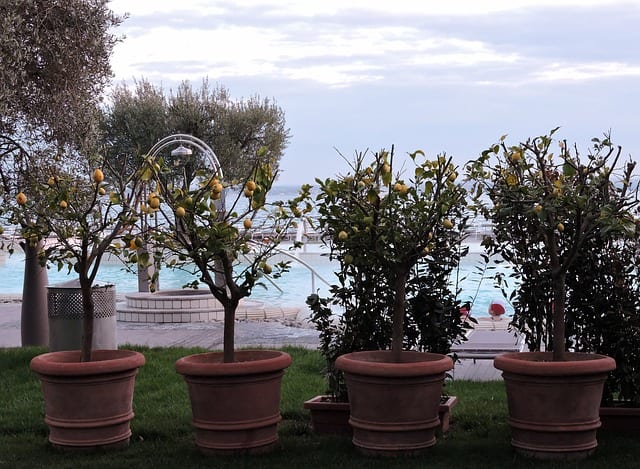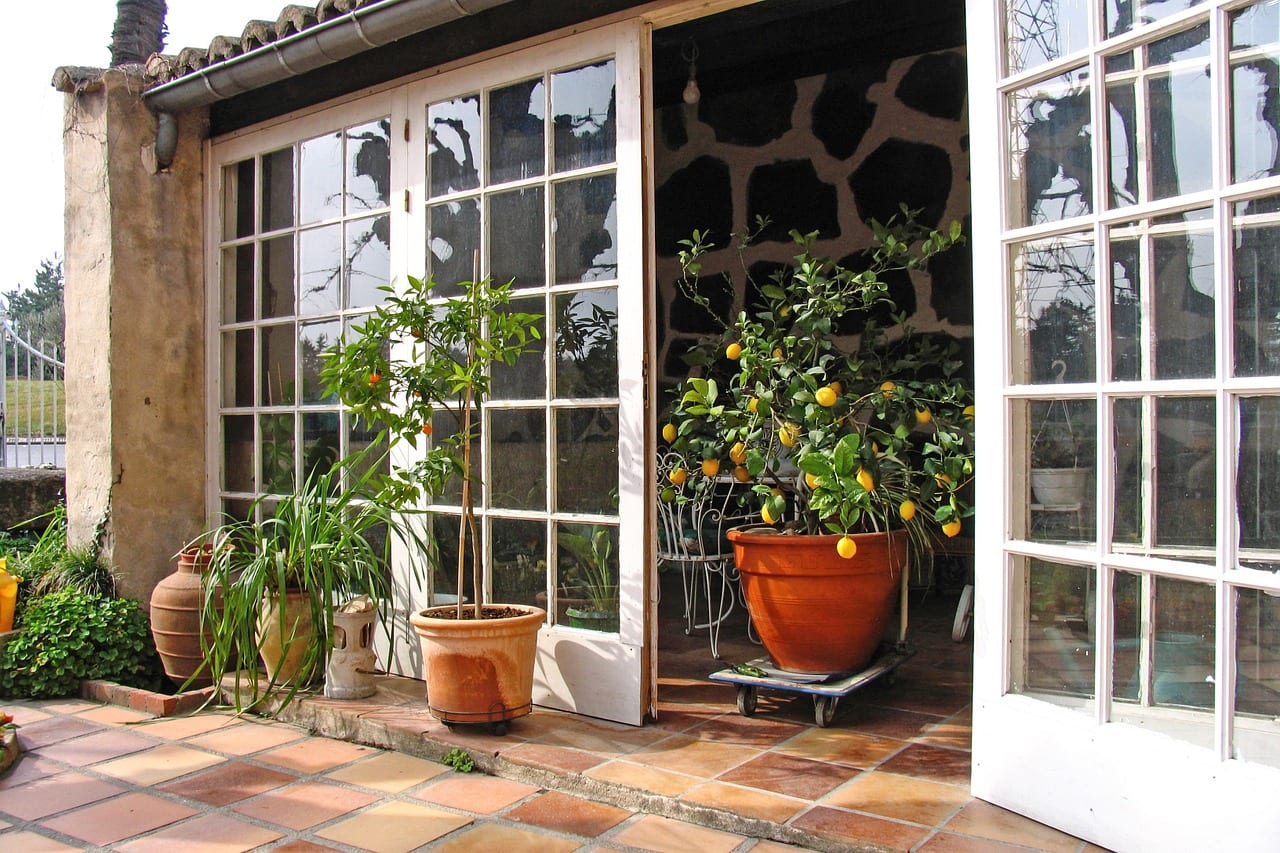Citrus is a big draw here in Texas. Who doesn’t enjoy a slice of lemon wedged on their refreshing glass of iced tea? Who doesn’t love the unmistakeable scent of citrus bursting from orange slices after a well-played soccer game. Citrus is synonymous with fresh. It’s scent, it’s taste, the sheer sight of it hanging from green-leaved trees just looks fresh. It’s no wonder the crowds come running when we get our new shipments of citrus trees at Rainbow Gardens. Today we’re giving our tips for successfully growing citrus in containers.
5 Tips for Growing Citrus in Containers
Choosing a Container for Citrus
Most of our citrus selections come in a 5 gallon container, (with a few other selections thrown in). —Whiskey barrels, or 15-20 gallon containers are about the right size for a mature tree. However, we recommend potting no larger than twice the diameter of the pot your purchased tree is in, and then increasing in pot size as the plant grows.
Whatever type of container you choose for your citrus, make sure that it has great drainage, or you will need to provide some by drilling holes.
Potting up your citrus allows you to move it to a sunnier location if needed, or to a protected area in the event of a prolonged freeze. (Setting your pot on top of a rolling plant stand or investing in a multi-functional dolly can help prevent injuries when moving your citrus.)

If you are potting up citrus, give them plenty of room for their roots.
Potting Soil for Citrus
High quality, well draining potting soil like FoxFarm Happy Frog Potting Soil, or Ocean Forest Potting Soil starts your citrus off with beneficial soil microbes already in the mix that improve root efficiency and nutrient uptake.
Remember, the roots of citrus plants in containers rely on you to provide the nutrients that they need to thrive and survive. FoxFarm soil is also full of aged forest products, bat guano and earthworm castings; all products that lend to plant vitality.
Fertilizer for Citrus
Add a slow-release granular fertilizer like, Espoma Citrus-Tone, or FoxFarm Happy Frog Citrus and Avocado Food to the potting soil, and then pot up your citrus tree (read instructions on fertilizer bag for correct application rate). For added nutrition, you can supplement with a liquid fertilizer weekly or every two weeks to really get your citrus going. Grow Big from FoxFarm gets your citrus producing vibrant, lush vegetation, then once flower buds appear, switch to Big Bloom from FoxFarm for abundant flower set and citrus production.

There are multiple choices for citrus fertilizer. Ask us for help. We’ll guide you.
Sun Requirements and Watering for Citrus
Place your pot in an area that gets full sun. You’ll realize your citrus tree is not getting enough sun if you notice your plant getting really leggy. You can prune the branches back and scoot your citrus over to an area with more sunshine. Water your citrus tree when it needs it. Let the soil at the top of the container dry out some between watering. I like the dip stick method to test the soil. I’m the dip, who sticks my finger down into the soil and if the soil sticks to my finger and feels wet, I pass on watering my citrus for a day or two. Watch the weather, hotter temps mean soil in pots dry out faster, cooler weather means you can lighten up on the frequency of your watering.
Cold Protection for Citrus
When freeze is in the forecast, take precautions to ensure the health and survival of your citrus. All citrus can be damaged at temps around 28°, citrus in pots can be susceptible to damage at slightly higher temperatures. Satsumas, calamondins, and kumquats are the most hardy citrus when it comes to a freeze, while limes, Meyer lemons and citron can be severely damaged at temps from 23-28°.
If citrus is left outside for the winter, it should be placed in an area that receives as much sun as possible, preferably on the south, southeast side of the house to protect from northern/northwest winds. You can further protect your citrus from freeze damage such as, wrapping incandescent Christmas lights around the tree to plug in at night. The combo of the lights along with a blanket and then plastic will give the tree a warm “greenhouse” effect. The cover should be taken off the next day once the temperature has risen above freezing for a few hours. Many people opt to bring the whole pot into a sunny, warm area of their home or garage to wait out the winter months.

See how the pot of citrus on the rolling dolly makes it a cinch to roll the citrus tree inside for winter protection?
~The Happy Gardener, Lisa Mulroy


I have a small patio. Are there dwarf size citrus plants that can stay in smaller pots?
Hi Nancy,
Satsumas are technically dwarf citrus, but you still need to pot your citrus in a 20 gallon sized pot, regardless of if it is dwarf or not.
I’m just starting a citrus orange tree from seed what do you recommend
I recommend starting with a 1& 1/2 year old tree from transplant! Sorry, not to be glib, but I think it is much more difficult to try growing citrus from seed than just buying a transplant from the nursery. With seed, you have to consider growing it on a rootstock (transplants have already been grafted). Take a look at this article from TAMU Extension Service and particularly the area about rootstock. Hope this helps.
How tall do lemon trees get? We will be planting our tree in the yard facing due West. Do we still put lights, blankets And plastic over it during freeze?
Sorry about the delay in response. This comment slipped by. Lemons can grow anywhere from 10-20 feet depending on the variety and care given. Yes, your citrus will need to be protected during winter temperatures. See this link on protecting young citrus trees and then also protecting mature citrus.
I purchased a dwarf meyer lemon tree this past weekend. It was already pollenated and tiny lemons were on some branches. Will repotting it now over-stress it where it might lose those fruits? I want to set my tree up for optimum success.
Hi Henry,
It should be ok to repot. Keep in mind that throughout its growing season, it is normal for lemons to abort some of its fruit. This could be due to stress, watering, variable weather temperatures. We had an unusually warm December and that pushed some citrus into bloom. True harvest for citrus in our area is in fall/winter. So don’t be alarmed if some of those fall off. It’s normal for what is going on.
Hello, so I have a 4 ft Meyer Lemon tree in a 5 gallon pot. It already has 22 little pea sized lemons on it and now has started blooming again. Should I remove all the new blooms so the energy goes into making the lemons that are already on it? Furthermore, should I leave all 22 lemons on the tree or remove some of the crop?
Thanks!
Hi Alex,
It is normal for citrus trees to abort some of its fruit, especially when it is produced early (lemons are ready for harvest here in fall and winter). So some of those pea sized lemons you see now will most likely fall off. Sometimes this is also due to water stress, and I would think about bumping your lemon tree up to a larger container as 5 gallons isn’t really that big for citrus and it is more likely that the soil in that pot will dry out quickly from the roots taking up space in the soil. Don’t remove the blooms, those are just producing more fruit and they might be the fruit that are able to stick around until fall and winter when your citrus will be ready for harvest. So, I would leave the fruit and blooms alone, repot to a larger container and feed citrus each month until October with a fertilizer like Espoma’s Citrus-tone.
My 3 ft tall lime tree has tons of blooms and little baby limes, but over the last couple of weeks, it has lost a bunch of leaves, with some of the stems almost bare. On closer inspection of some leaves, they are barely hanging on like something has eaten them off just where they join the stem. What could cause this? I have looked for worms or bugs but could not find anything. And I didn’t want to spray insecticide because of all the bees and butterflies pollinating on it.
I don’t want to lose the tree…HELP 🙂
So your leaves are not turning yellow before they drop off? And you don’t see any signs of frass (caterpillar poop) anywhere on the leaves, plant, or below? Do you see any sign of new leaves filling in? Because citrus trees can have a big flush of new growth in the spring and can lose a lot of leaves, but generally they turn yellow first and drop because it is the end of their life cycle, but you should see signs of new growth. I ask about the caterpillar frass because citrus in a host plant.
How was your citrus taken care of through winter? Temperature fluctuation could be a culprit. Have you recently replanted your citrus? Is it in a pot or the ground? Sorry so many questions, but need the info to get best diagnosis. Can you take apicture of the whole plant, and then a couple close ups that are in focus?
Thanks for the reply. Here is the info you asked for.
No frass noted
It’s in a large pot…always has been.
We left it outside in the winter, and moved it to garage only when temps were getting into the 20’s, then moved it back out again as it got a over 35 degrees.
Leaves don’t seem to turn yellow before they fall off. As you can see in the pictures, some seem a little “curled”.
Cheryl Foley
Curious about your drainage and your watering schedule. First thoughts are that maybe it is overwatered with poor drainage and it got stressed out. We’ve also has some very windy days lately.
You could either: add some perlite to the soil, mix it as best you can and this can help provide some oxygen to the roots. The limbs should re-foliate, or wait it out and really space out your waterings. Either way double check you have adequate drainage hole at bottom of pot, and make sure it is not sitting on a surface that may retain water.
Going forward, you can add 2 TBSP of epsom salts to one gallon of water monthly, and fertilize 1 x monthly as well.
Let me know about your drainage and we can re-evaluate from there.
more images
one more image